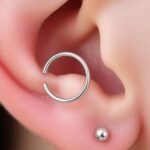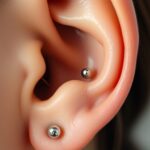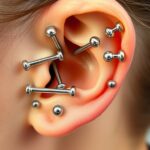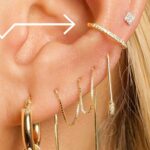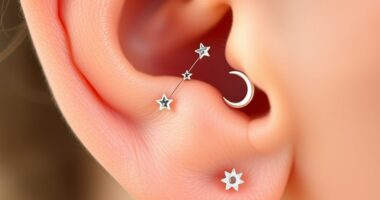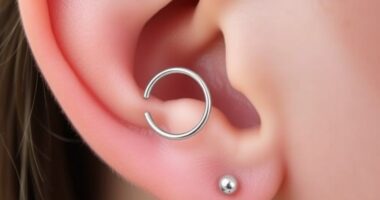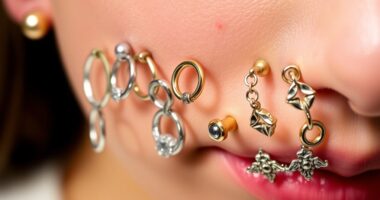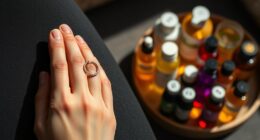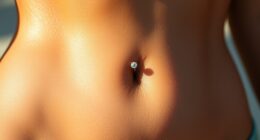Orbital piercings connect two holes with a single ring, offering a striking ear design that's become increasingly popular. You can choose placements like earlobe to earlobe or helix to helix, each with unique aesthetics and varying pain levels. While earlobes generally hurt less, healing can take between six weeks to two years, depending on the location. Aftercare is essential to avoid complications, including infection and irritation. It's also important to select skin-friendly jewelry materials, like titanium or surgical steel. If you're curious about styles, healing tips, and more, there's plenty more to explore to enhance your piercing journey.
Key Takeaways
- Orbital piercings connect two holes with a single piece of jewelry, typically a ring, and can be placed in various locations on the ear.
- Healing times vary significantly; earlobe piercings heal in about 6 weeks, while cartilage can take up to 2 years.
- Pain levels for orbital piercings average around 5 out of 10, with earlobe placements generally causing less discomfort than cartilage piercings.
- Proper aftercare, including regular cleaning and avoiding swimming, is essential to prevent infections and complications during the healing process.
- Jewelry options include titanium and surgical steel for hypoallergenic properties, with styles like captive bead rings and circular barbells being popular choices.
What Is an Orbital Piercing?

If you're looking for a unique way to express your style, an orbital piercing might be just what you need. This eye-catching type of ear piercing consists of two holes connected by a single piece of jewelry, typically a ring.
Unlike an industrial piercing, which uses a barbell, the orbital piercing stands out for its distinctive ring design, offering a bold aesthetic.
You can choose from various placements, like connecting your earlobe to earlobe, helix to helix, or conch to conch.
However, you should be aware that the piercing process involves two punctures close together, which can increase the pain level compared to single ear piercings. While some people might find the discomfort manageable, it's important to be prepared for the sensation.
The healing time for an orbital piercing varies based on its location. Earlobe connections generally heal faster than those in cartilage, which can take anywhere from 6 months to 2 years.
As you consider this unique style, keep in mind the commitment to aftercare and patience required for proper healing. With the right approach, you'll enjoy your beautiful new look!
Orbital Piercing Placement Options

Choosing the right placement for your orbital piercing can greatly enhance your overall look. Popular options include connecting lobe piercings, helix to helix, and conch to conch, each offering unique styles. If you're new to piercings, you might find the earlobe orbital less painful than cartilage placements, making it a favorite for beginners.
Proper spacing is vital for a successful healing process, so consulting an experienced piercer is important. They can help you navigate your individual anatomy and recommend the best placement for your desired look. Some placements, like the rook orbital, require additional piercings, while others can connect existing ones for a streamlined appearance.
Before attempting an orbital connection, make certain to wait for the full healing of individual piercings. This minimizes complications and guarantees you can enjoy your new design without issues.
Don't forget proper aftercare; it plays a significant role in the healing process and can help you avoid unnecessary piercing pain. By carefully considering your placement options and following aftercare guidelines, you can create a stunning, customized look that reflects your unique style.
Pain Levels of Orbital Piercings

Pain levels for orbital piercings can be a concern for many, especially since this unique style involves piercing two holes simultaneously. On average, you can expect a pain level of around 5 out of 10. However, pain varies considerably depending on the placement of the piercings.
Here's what you should consider regarding pain levels:
- Earlobe vs. Cartilage: Earlobe placements generally result in less discomfort compared to cartilage locations.
- Jewelry Insertion: Increased discomfort can occur during the jewelry insertion phase, as two holes are pierced at once.
- Individual Tolerance: Your personal pain tolerance will greatly influence how intense or manageable the pain feels.
- Healing Time: Cartilage placements take longer to heal, potentially leading to more prolonged sensitivity.
- Aftercare Impact: Proper aftercare can minimize pain and discomfort during the healing process.
Understanding these factors can help you prepare for the experience. While there will be some pain, many find that the unique look of orbital piercings is worth it.
Just remember, healing will play a considerable role in your overall experience with these stylish piercings.
The Healing Process Explained

Healing your orbital piercing can take quite a bit of time, with earlobe placements healing in about six weeks and cartilage ones stretching up to two years.
Proper aftercare is essential to manage swelling and irritation bumps that often arise during this process. By following best practices for cleaning and care, you can help guarantee a smoother healing experience.
Healing Timeline Variability
Understanding the variability in healing timelines for orbital piercings is essential for anyone contemplating this type of body modification. The healing time can range considerably, with earlobe placements healing in about six weeks, while cartilage piercings may take up to two years. Factors like placement, blood flow, and tissue characteristics play an important role in this process.
Here are some key points to reflect on regarding healing timelines:
- Earlobe piercings typically heal faster than cartilage piercings.
- Swelling can complicate the healing process, especially in tight spaces.
- Irritation bumps are common and require patience to manage.
- Proper aftercare is essential for reducing complications.
- Individual factors, like health and lifestyle, can affect healing time.
Being aware of these aspects helps you set realistic expectations.
Remember that maintaining consistent aftercare is crucial to avoid prolonged healing and potential complications.
The journey to a healed orbital piercing might be long, but understanding these variables can make the experience more manageable.
Stay patient, and give your body the time it needs to heal properly.
Aftercare Best Practices
Caring for your orbital piercing is essential to guarantee a smooth recovery and prevent complications. Start by cleaning the area twice daily with a saline solution or unscented antibacterial soap. This routine helps prevent infection and promotes proper healing.
Remember, healing times can vary; earlobe piercings may take about 6 weeks, while cartilage placements can take anywhere from 6 months to 2 years to become fully healed.
Avoid sleeping on the piercing during this time. Consider using a donut or airplane pillow to minimize pressure on the area. Regularly check for irritation bumps or signs of infection, as these can complicate the healing process. If you notice any concerning symptoms, consult your professional piercer for advice.
To reduce the risk of snagging and irritation, steer clear of swimming and don't change your jewelry until the piercing is fully healed.
Following these aftercare best practices will guarantee your orbital piercing heals properly and looks great in the long run. Stay consistent with your routine, and you'll enjoy your unique ear design without complications.
Essential Aftercare Steps

When you've just gotten an orbital piercing, following essential aftercare steps is crucial for a smooth healing process. Proper cleaning and maintenance can greatly reduce the risk of infection and promote faster healing.
Here are some key aftercare tips to keep your piercing in top shape:
- Clean the orbital piercing daily with warm water and unscented antibacterial soap.
- Use a saline solution to spray the piercing two to three times daily.
- Avoid sleeping on the piercing; consider using a donut or airplane pillow.
- Always wash your hands thoroughly before touching the piercing.
- Refrain from swimming, changing jewelry prematurely, and using harsh cleaning agents.
Jewelry Options for Orbitals

When it comes to choosing jewelry for your orbital piercings, you'll want to contemplate materials that won't irritate your skin, like titanium or surgical steel.
Understanding the different ring styles, such as captive bead rings and circular barbells, can help you find the perfect fit.
Plus, knowing how to shift jewelry safely guarantees your piercings stay healthy and comfortable throughout the healing process.
Jewelry Material Choices
Choosing the right jewelry material for your orbital piercings is vital for both comfort and style.
When selecting jewelry, you want something that looks great and minimizes irritation during the healing process. Here are some popular options to take into account:
- Titanium: Highly recommended for its hypoallergenic properties, making it safe for sensitive skin.
- Surgical Steel: Durable and affordable, but make certain it's nickel-free to avoid allergic reactions.
- Gold: Opt for solid gold or 14k gold to reduce the risk of irritation; avoid plated options.
- Captive Bead Rings: A common choice that offers both aesthetic appeal and secure fit.
- Circular Barbells: Another stylish option that provides flexibility and comfort.
Ring Styles Explained
What styles of rings can elevate your orbital piercings? When it comes to orbital piercings, your primary options are captive bead rings and circular barbells. These ring styles connect the two piercings, creating a unique aesthetic that stands out.
However, your initial jewelry choice is vital, especially during the healing process. Opt for materials like titanium, surgical steel, or gold, as these are hypoallergenic and minimize irritation.
It's important to maintain the same gauge and diameter when switching to different ring styles to guarantee comfort and prevent complications. While captive bead rings provide a sleek look, circular barbells offer versatility and ease of changing up your style later on.
Once your piercings have healed, you'll find a wide variety of decorative options available, including rings adorned with gemstones or intricate designs that let your personality shine.
Keep in mind that while rings can be visually striking, they might complicate recovery compared to studs or labrets during the healing phase. So, choose wisely, and enjoy the journey of transforming your orbital piercings into a stunning feature of your style!
Transitioning Jewelry Safely
Shifting your jewelry for orbital piercings can be a smooth process if you follow the right steps. To guarantee a successful change, here are some key considerations:
- Maintain the same gauge and diameter: This helps avoid irritation during the healing process.
- Start with two labrets: Using labrets initially can aid in healing before switching to a hoop or ring.
- Choose hypoallergenic materials: Opt for titanium or surgical steel to minimize allergic reactions.
- Wait until fully healed: Before making any changes, confirm your piercings are completely healed to prevent complications.
- Consult an experienced piercer: They can provide guidance on proper techniques and jewelry options.
Once your piercings have healed, you can introduce a variety of jewelry styles, like captive bead rings or seamless rings, to enhance your look.
Risks and Complications

While most people consider orbital piercings to be a unique form of self-expression, it's essential to acknowledge the potential risks and complications that can arise. One of the primary concerns is infection. If you don't follow proper aftercare—like regular cleaning and avoiding touching the area—you increase your risk of developing an infection.
Another issue to be aware of is keloids. If you're prone to scarring, raised scar tissue may form around the piercing site, which can be unsightly and uncomfortable.
Additionally, the jewelry you choose plays a significant role in your experience. If it's not the right size or material, you might face the risk of migration or rejection, which can lead to further complications.
Improperly performed orbital piercings can even damage surrounding tissues or pose a risk to your eye, given the close placement.
Cultural Significance of Orbital Piercings

Orbital piercings hold a deep cultural significance that transcends mere aesthetics, as they often embody personal identity and community belonging. For many, these piercings are a powerful form of self-expression, particularly within subcultures like punk and goth. You might find that the appeal of orbital piercings has been amplified by celebrity endorsements and social media, making them more accepted in mainstream culture.
The cultural significance of orbital piercings can be understood through several key aspects:
- Rebellion: They often symbolize a challenge to societal norms.
- Individuality: Each design can reflect personal style and uniqueness.
- Community: They foster connections among those who share similar beliefs about body modifications.
- Artistic Expression: Many view them as an art form that enhances one's appearance.
- Varied Perceptions: Different cultures may embrace or criticize these modifications, affecting how they're viewed.
In essence, orbital piercings represent more than just body modifications; they signify a deeper narrative of identity, belonging, and cultural richness that resonates with many individuals.
Community Experiences and Insights

When it comes to community experiences with orbital piercings, many enthusiasts emphasize the blend of aesthetic appeal and personal expression. The aesthetic allure of double rings often enhances personal style, making each piercing unique. However, choosing an experienced piercer is crucial; proper placement guarantees comfort and aids the healing phase.
Here's a glimpse into shared experiences within the community:
| Experience | Insight | Tip |
|---|---|---|
| Initial Pain | Many report significant discomfort. | Prepare mentally. |
| Healing Phase | Patience is key; it takes time. | Follow aftercare tips. |
| Satisfaction | Final looks often exceed expectations. | Celebrate your style! |
Community members frequently discuss the importance of aftercare. Consistent cleaning and patience help prevent complications, guaranteeing your piercing heals well. Online forums and local groups can be invaluable resources for insights and support, allowing you to connect with others who've navigated this journey. Researching and consulting experienced piercers and other individuals can guide you in making informed decisions, ultimately enhancing your orbital piercing experience.
Transitioning Jewelry Post-Healing

Once your orbital piercing has fully healed—typically between 6 months to 2 years—you can plunge into the exciting world of jewelry options. Changing jewelry post-healing is an opportunity to express your style, but it's important to do it right to avoid complications.
Here are some key considerations for selecting your new jewelry:
- Stick with the same gauge and diameter to guarantee a proper fit.
- Opt for hypoallergenic materials like titanium or surgical steel to minimize irritation.
- Think about starting with two labret studs to allow for best healing before switching to a hoop or ring.
- Consult with a professional piercer for advice on the best jewelry options.
- Choose styles that suit your aesthetic while making sure they won't cause movement or pressure on the piercing.
Frequently Asked Questions
What Are the Rarest Ear Piercings?
The rarest ear piercings include the transverse lobe, triple helix, daith, rook, snug, and industrial. Each offers unique aesthetics and requires specific anatomy, skill, and pain tolerance, making them less common choices for piercings.
What Is the Difference Between a Conch and Orbital Piercing?
Imagine two paths in a forest. A conch piercing is a single trail through thick trees, while an orbital piercing connects two trails with a shimmering bridge. Both offer unique beauty and healing journeys.
What to Know Before Getting an Orbital?
Before getting an orbital piercing, you should consider the healing time, pain level, and aftercare requirements. Make sure to consult a skilled piercer for ideal placement and choose jewelry that supports healing effectively.
How Painful Are Orbital Piercings?
Orbital piercings can be around a 5 out of 10 on the pain scale. You'll likely feel more discomfort with cartilage placements. Just remember, the sensation doubles due to the close proximity of the piercings.
Conclusion
In the world of body art, orbital piercings stand out as both bold statements and delicate expressions of individuality. While the initial pain might sting, the beauty of unique designs can transform that discomfort into a badge of honor. As you navigate the healing process and embrace the vibrant community around you, remember that every piercing tells a story—your story. So, whether you're drawn to its aesthetic or its cultural roots, let your orbital piercing reflect the complexity of who you are.




